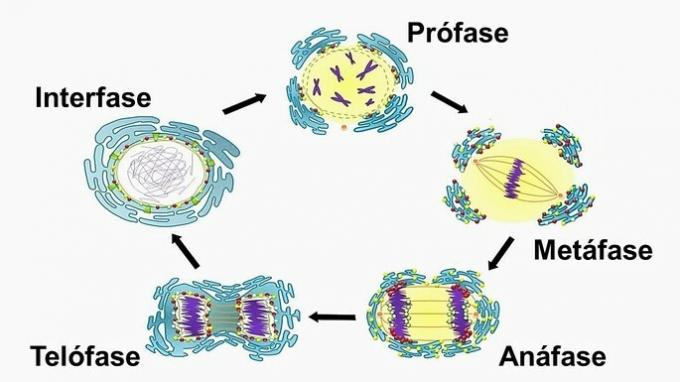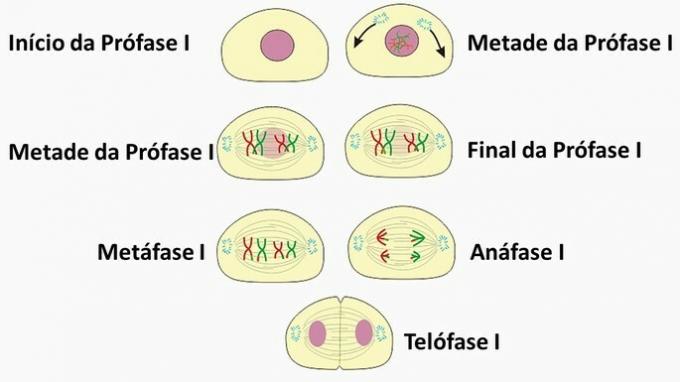Mitosis is the process of cell division that gives rise to two cells equal to the initial one, that is, with the same number of chromosomes. In meiosis, on the other hand, two cell divisions occur, forming four cells with half the genetic material of the mother cell.
Both processes are part of our body, although they occur in different situations. Mitosis can occur in haploid and diploid cells, while meiosis occurs only in diploid cells.
Check out the main differences, the phases of the two processes below, and test your knowledge with entrance exam questions at the end of the summary.
Differences between mitosis and meiosis
| Mitosis | Meiosis |
|---|---|
| Cell division occurs. | There are two cell divisions. |
| Two cells are produced. | Four cells are produced. |
| The cells formed are genetically identical. | The cells formed are genetically modified. |
| There is a duplication of diploid cells (2n). | There is the transformation of diploid cells (2n) into haploid cells (n). |
| Fair process, as daughter cells have the same number of chromosomes as the mother cell. | A reduction process, as daughter cells have half the number of chromosomes as the mother cell. |
| One cell can generate many others, as the mitotic cell cycle repeats itself. | Only four daughter cells are formed, which may not undergo further duplication. |
| It occurs in most of the body's somatic cells. | Occurs in germ cells and spores. |
See too: cell division and cell cycle
Mitosis and Meiosis Summary
THE cell division generates profound changes in cells. The two existing types, mitosis and meiosis, occur in different ways. Check out here a summary of what happens in the two processes.
Mitosis: what it is, function and importance
Mitosis is a process of cell division where a cell gives rise to two cells identical to the mother cell, that is, with the same number of chromosomes. The term mitosis originates from the Greek word myths, which means weaving yarn.
The function of mitosis is to ensure the growth and replacement of cells. The importance of this cell multiplication lies in maintaining the reproduction of unicellular beings, effecting healing processes and tissue renewal.
This type of cell division occurs in diploid cells and in some animal and plant cells. In a human cell, for example, there are 46 chromosomes. Mitosis promotes the emergence of two cells also with 46 chromosomes.
See too: mitosis
phases of mitosis

prophase
- Each chromosome has a centromere that joins two strands called chromatids.
- The membrane surrounding the nucleus, the caryotheca, is fragmented and the nucleolus disappears.
- Chromosomes become shorter and thicker with the spiraling process.
- The formation of spindle fibers facilitates displacement into the cytoplasm.
See too: cell nucleus
metaphase
- Nuclear material is dispersed in the cytoplasm due to the disappearance of the caryotheca.
- Chromosomes are in a maximum degree of spiralization and are joined to the polar fibers of the mitotic spindle through the centromere region.
- Chromosomes shift to the middle region of the cell, forming an equatorial plate.
See too: cytoplasm
Anaphase
- The two sister chromatids are separated by dividing the centromere, making the daughter chromosomes independent.
- Each child chromosome is directed to a pole of the cell by shortening the spindle fibers.
- The genetic material that arrives at each pole is identical to that of the mother cell.
See too: chromosomes
telophase
- The nuclear division ends and the chromosomes unwind, becoming again long and thin filaments.
- There is the disintegration of the spindle, reorganization of the nucleolus and reconstitution of the caryotheque.
- The new nuclei acquire the same aspect as the interphase nucleus.
- Cytokinesis causes the cytoplasm to divide and strangulation to produce two cells.
In the period of interface, the cells are not in the process of dividing. This phase is divided into three periods: G1 (RNA synthesis), s (DNA synthesis) and G2 (preceding duplication).
know more about:
- DNA
- RNA
Differences between animal and plant mitosis
| Mitosis in animal cells | Mitosis in plant cells |
|---|---|
| Centric mitosis due to the presence of centrioles. | Acentric mitosis due to the absence of centrioles. |
| Astral mitosis due to the presence of aster fibers. | Anastral mitosis due to the absence of aster fibers. |
| Centripetal cytokinesis, that is, it occurs from the outside to the inside. | Centrifugal cytokinesis, which occurs from the inside out. |
When a preexisting cell gives rise to a new cell, a cell cycle, which ends when duplication occurs and, consequently, the formation of daughter cells. Therefore, the cycle is the time it takes to make all the changes.
See too: animal and plant cell
Meiosis: what it is, function and importance
Meiosis is a process of two nuclear divisions, where the transformation of a diploid cell into four haploid cells occurs through meiosis 1 and meiosis 2.
The function of meiosis is to reduce the number of chromosomes in diploid cells by transforming them into cells haploids and, finally, ensure that there is a complete set of chromosomes in the haploid products generated.
Meiosis is important in the development of genetic diversity, as it produces new gene combinations. Sexual life cycles are influenced by this process, with diversity being the raw material of natural selection and evolution.
See too: meiosis
Meiosis Phases 1

Stands for reduction step, which consists of reducing the number of chromosomes by half.
Prophase 1
- Centrioles move to the poles of the cell.
- Chromosome condensation occurs.
- Formation of chromomers, which correspond to small, dense condensations on chromosomes.
- There is an exchange of fragments between homologous chromatids during the crossing over.
See too: centrioles
Metaphase 1
- The cell membrane disappears.
- Chromosomes are at their maximum level of condensation.
- The kinetochore connects the homologous chromosome pair to the spindle fibers.
- You homologous chromosomes line up in pairs in the equatorial region of the cell.
See too: cell membrane
Anaphase 1
- The separation of homologous chromosomes occurs due to the shortening of the aster fibers.
- The duplicated chromosome from each pair migrates to one of the cell's poles.
- Decondensation starts.
See too: cell
Telophase 1
- The caryotheca and nucleolus reorganize at each pole of the cell.
- Cell division and formation of two haploids with half the number of chromosomes in the mother cell.
- Cytokinesis, that is, the division of the cytoplasm, occurs.
See too: nucleolus
Meiosis Phases 2

Stands for equational step, which consists of the division of cells and the number of chromosomes is equal to those that started the process.
Prophase 2
- The caryotheque is disrupted and the nucleoli disappear.
- Chromosomes condense.
- The aster fibers form.
- Cells are haploid, as they have one chromosome of each type.
Metaphase 2
- The chromosomes are oriented by the aster fibers and line up in the equatorial region of the cell.
- Chromosomes are at their maximum degree of condensation.
Anaphase 2
- The sister chromatids are directed by the aster fibers to opposite sides.
- A chromatid becomes a simple chromosome.
- Decondensation starts.
Telophase 2
- The cells formed are haploid.
- The caryotheque reorganizes and the nucleolus reappears.
- Cytokinesis causes cell separation to occur.
The entire process can be summarized as follows:
See too: haploid and diploid cells
Differences between animal and plant meiosis
| Meiosis in animal cells | Meiosis in plant cells |
|---|---|
|
Gametic meiosis due to the formation of gametes: sperm (male gamete) and egg (female gamete). |
Sporadic meiosis due to spore formation. |
know more about:
- spores
- Gametes
Cell division exercises with commented template
1. (Fuvest/2012) Consider the events below, which can occur in mitosis or meiosis:
I. Pairing of duplicated homologous chromosomes.
II. Alignment of chromosomes in the equatorial plane of the cell.
III. Permutation of segments between homologous chromosomes.
IV. Division of centromeres resulting in separation of sister chromatids.
In the process of cell multiplication for tissue repair, events related to the equitable distribution of genetic material among the resulting cells are indicated in
a) I and III, only.
b) II and IV only.
c) II and III only.
d) I and IV only.
e) I, II, III and IV.
Correct alternative: b) II and IV only.
Cell multiplication and equitable distribution of genetic material occur in Mitosis. Of the events listed, only the alignment in the equatorial plane of the cell (II) and separation of the sister chromatids (IV) are part of this cell division.
I. The pairing of homologous chromosomes occurs only in Meiosis, in the Prophase 1 phase.
II. Alignment in the equatorial plane of the cell occurs in Mitosis, in the Metaphase phase, and in Meiosis 2, in the Metaphase 1 phase.
III. The permutation of segments between homologous chromosomes only occurs in Meiosis, in the Prophase 1 phase.
IV. The separation of the sister chromatids takes place in Mitosis, in the Anaphase phase, and in Meiosis 2, in the Anaphase 2 phase.
2. (Vunesp/2007) Tick the alternative that represents the correct association between the type of cell division and the processes that take place during division.
a) Mitosis – production of gametes with a reduction in the number of chromosomes.
b) Meiosis - occurrence of crossing over or permutation in Prophase I.
c) Meiosis – number of daughter cells at the end of the process is twice the number of mother cells.
d) Meiosis – production of 2n cells after Meiosis I.
e) Mitosis – pairing of homologous chromosomes in Prophase.
Correct alternative: b) Meiosis - occurrence of crossing over or permutation in Prophase I.
a) WRONG. Gametes are produced in Meiosis.
b) CORRECT. There is an exchange of fragments between homologous chromatids.
thick. Four daughter cells are produced with half the number of chromosomes as the mother cell.
d) WRONG. Haploid (n) cells are produced after Meiosis I.
it's wrong. Homologous chromosomes are paired in Prophase I of Meiosis.
3. (Colégio Naval/2015) In our body there are two types of cell division: mitosis, in body cells in general, and meiosis, in germ cells. Regarding mitosis and meiosis in the human body, it is correct to state that
a) in mitosis, from initial cells with 46 chromosomes, cells with half the number of chromosomes are formed.
b) mitosis is the cell division that forms sperm and eggs.
c) in meiosis, from initial cells with 46 chromosomes, cells with 23 chromosomes are formed.
d) Meiosis is cell division that allows organisms to grow and replace aging and dying cells.
e) both in mitosis and meiosis, chromosome loss occurs during cell division.
Correct alternative: c) in meiosis, from initial cells with 46 chromosomes, cells with 23 chromosomes are formed.
a) WRONG. Mitosis has the function of cell multiplication. Therefore, an initial cell with 46 chromosomes will form cells with the same number.
b) WRONG. Sperm (male gamete) and ovum (female gamete) are haploid cells, that is, reproductive cells formed in cell division by meiosis.
c) CORRECT. A diploid cell (2n) is transformed into haploid cells (n) through meiosis. In this process, the number of chromosomes is halved.
d) WRONG. Cell growth and cell replacement are functions of mitosis. Meiosis is responsible for the formation of gametes in multicellular organisms.
it's wrong. The number of chromosomes in mitosis remains the same as in the mother cell.


